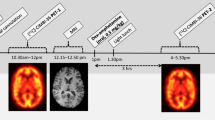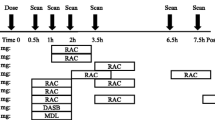Abstract
The augmentation effect of (–)pindolol as used in combination with SSRI to treat major depression has been ascribed to blocking of dorsal raphe nucleus cell body 5-HT autoreceptors. In this study, the radioligand [carbonyl-11C]WAY-100635 and positron emission tomography were used to establish whether pindolol at a clinical dose level (10 mg s.o.d.) occupies 5-HT1A receptors in the human brain in vivo. Three healthy males were recruited and each subject was used as his own control. The 5-HT1A receptor occupancy was calculated for the frontal and temporal cortex and the raphe nuclei, using and a ratio analysis with the cerebellar cortex as the reference region. Maximal pindolol plasma concentration was reached within 3 h after drug administration. Two hours after pindolol administration, the regional 5-HT1A receptor occupancy was within the range 7–21% in the three subjects. The study confirms that the 5-HT1A-receptor may be a clinically significant target for pindolol.
Similar content being viewed by others
Author information
Authors and Affiliations
Additional information
Received: 8 March 1999 / Final version: 15 March 1999
Rights and permissions
About this article
Cite this article
Andrée, B., Thorberg, SO., Halldin, C. et al. Pindolol binding to 5-HT1A receptors in the human brain confirmed with positron emission tomography. Psychopharmacology 144, 303–305 (1999). https://doi.org/10.1007/s002130051009
Issue Date:
DOI: https://doi.org/10.1007/s002130051009




